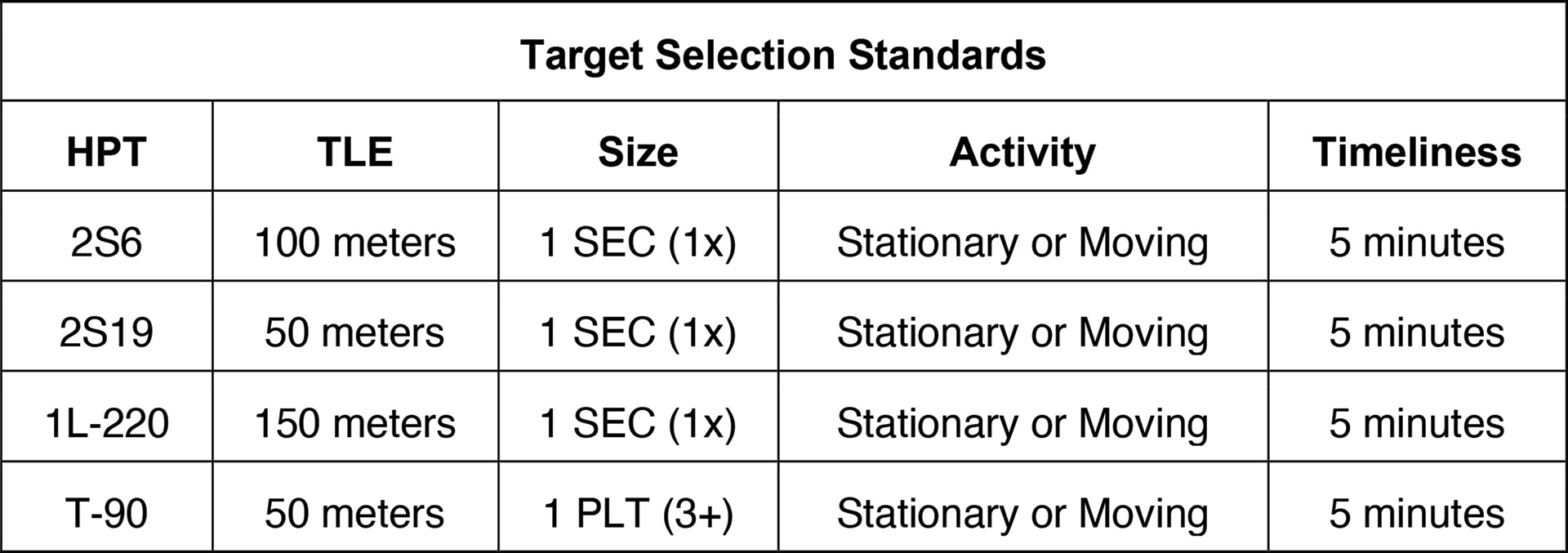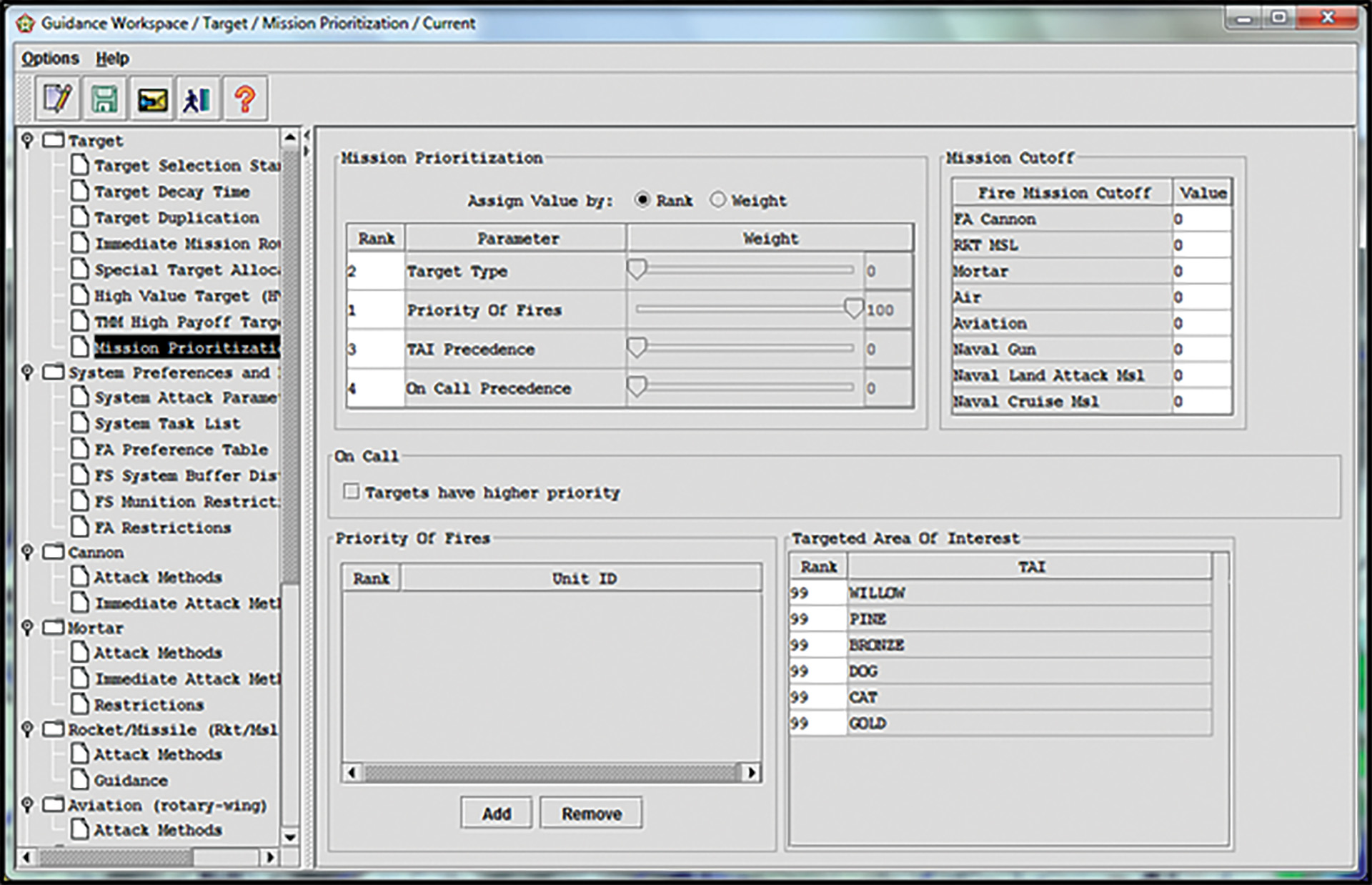Deliberate Dynamic Targeting
By CW3 David Brown
Article published on: March 1, 2024 in Field Artillery 2024 Issue 1
Read Time: < 6 mins

Rotational Training Units (RTUs) at the
National Training Center (NTC) often do a
respectable job adhering to and conducting
their battle rhythm targeting events. They tend
to not do as well publishing the orders products
resulting from this meeting, however. Targeting
product development and distribution, especially
target selection standards (TSS) and attack
guidance matrices (AGMs), continues to challenge
units. Additionally, inconsistent adherence to
the priorities listed therein when confronted by
target simultaneity or troops in contact (TICs) is a
recurrent trend for some units. The best targeting
tools are simple, specific and specified, allowing for
rapid execution or decision making when leaders
confront variance or circumstances requiring
adjustments.
Firstly, Target Selection Standards apply
the criteria of target location error (TLE), size,
activity (stationary or moving) and timeliness
to reports about enemy activity to help analysts
determine what enemy objects are actionable
targets versus just suspected targets which need
further development or confirmation.
Example Standalone Target Selection Standards
- High-payoff Target (HPT): Refers to specific,
prioritized commander approved targets that
collection assets must acquire for a given
phase, critical event, battle period, or Air
Tasking Order (ATO) day. Generated from
high value targets (HVTs).
- Target Location Error (TLE): Measurement of
the difference between actual and perceived
target locations. Here, it means the maximum
allowed sensor detection error, expressed as
a circular radius in meters, to engage targets.
Varies by weapon system.
- Timeliness: Latest time information is of value
(LTIOV) to weapon systems based on the target’s expected dwell time or on station
time. To use a sports analogy, this is your
shot clock or how long you have to take the
shot and engage the target before needing
to reconfirm that the target is still present or
actionable.
- Activity: Describes the status of the enemy
activity required for engagement. Varies by
weapon system.
- Size: Minimum number of target elements
required for targeting or worth engaging.
May also vary by weapon system.

Because several TSS elements vary by weapon
system (TLE, activity, size), many targeting officers choose to combine the TSS and high-payoff target
list (HPTL) with the AGM.
Example combined HPTL, AGM and TSS
Regardless of format, the field artillery
intelligence officer (FAIO) uses target selection
standards to keep the brigade intelligence-support
element (BISE) focused on acquiring and developing
the HPTs in the areas the unit needs to attack to
ensure success of the friendly course of action.
As such, they should drive its development and
enforce its use. Typically at NTC, new or junior S2
analysts send a lot of raw data, not information,
that isn’t actionable. The FAIO filters, prioritizes
and converts that data to information, sending
actionable targets to the appropriate shooters or fire support elements (FSEs) in accordance with
commander targeting priorities and the unit’s
operational framework.
Notional FAIO steps in Killing a Target
- Sensor acquires a target. Analysts passes
target information to FAIO.
- FAIO checks acquisition/report time to
determine validity.
- FAIO evaluates target: HPT, size, & activity
check. TLE check. Request collection cross
cueing for target location refinement if
necessary.
- FAIO generates fire mission and sends to
appropriate echelon shooter based on target
location and operational framework (Inside/
Outside AO, long/short of BDE/DIV CFL, etc.)
- FAIO prompts collection for BDA if target
requires it.
- FAIO prompts BISE to update common
intelligence picture.
An attack guidance matrix (AGM) is a commander
approved targeting tool that addresses when and
how to attack targets and the desired effects against
those targets. As such, deviations from this product
should be rare and informed by knowledgeable
decision makers. Effective AGMs are intelligible,
specific, consistent and distributed to the current
operations (CUOPs) at large.
Example Attack Guidance Matrix
- High-payoffTarget(HPT): Refers to specific,
prioritized commander approved targets
that collection assets must acquire for a
given phase, critical event, battle period,
or Air Tasking Order (ATO) day. Generated
from HVTs.
- When: Probably the most misunderstood
part of the AGM. This column comparatively
indicates when the target should be attacked
and is tantamount to mission precedence.
As such, this column should mirror your HPT
priority; this is to say, immediate (I) targets
correspond to higher priority targets. We’ve
seen some units list their third or fourth
priority HPT as an “immediate” strike, causing
confusion during execution regarding what to
strike first, the immediate or the supposedly
“higher” priority target on the HPTL.
- How: Weapon systems (in order of
employment priority) that will engage the
target.
- Effect: Desired effects, physical and
functional, against the target and or target
system.
- Remarks: Battle damage assessment (BDA)
requirements, coordination requirements,
attrition goals, criteria for HPTL change,
measures of performance (MOPs) and
measure of effectiveness (MOEs), etc.

Lastly, your tools are only as good as the thought
and flexibility you’ve put into them because they
have limits. The AGM, for example, doesn’t account
for all the planning factors or machine variables
that can actually determine fire mission value in
operations or in Advanced Field Artillery Tactical
Data System (AFATDS). While accounting for high payoff targets, the standard AGM leaves out other
factors that could influence fire mission value. Four
variables determine fire mission value in AFATDS:
- Target Type (High-payoff Target)
- Priority of Fire
- TAI Precedence
- On Call Target Precedence
As a thought experiment, consider the case
of units simultaneously calling for fire. Whose
targets would you service first: a unit with priority
of fire calling for fire on targets that don’t meet
the TSS/AGM or a unit calling for fire on HPTs that
presumably do? The “correct” answer, in truth,
varies according to the circumstances ruling at
the time and your commander’s intent. The case
for HPT importance is self-evident but prioritizing
priority of fire may be appropriate when a main
effort battalion/squadron is leading a brigade attack
or movement to contact and risks culminating. Deliberate targeting becomes deliberate dynamic
targeting when we recognize, adapt to and confront
variance in our plans. As fire supporters, we
are often the first to recognize the operational
importance of indicators and spot reports in the
command post as it relates to resource requests
and synchronization in support of the maneuver
plan. This analysis should occur in real time during
operations when any reports come in. It could also
occur during synchronization drills such as a two
or seven minute drill.
Notional Deliberate to Dynamic Targeting
Sequence Informed by Information
In any case, the targeting working group (TWG)
is the primary deliberate synchronization meeting
where you plan, establish and rank proposed
priorities for commander approval before the
target decision board (TDB). Your targeting
priorities and the criteria for their change,
produce requirements and really matter in the
case of target simultaneity, when you may be
only able to prosecute a few targets when many
present themselves. Targeting products are the
commander’s priorities, information aids and
execution tools. Without priorities or execution
tools, units run the risk of prosecuting targets
in a first in first out undisciplined fashion while
potentially more impactful targets languish in
a Joint Battle Command-Platform (JBC-P) chat
or AFATDS target workspace queue. The most
effective units keep their priorities simple, specific,
specified and socialized with the entire CUOPs
down to the JBCP operator who may be the only
one calling out reports in the command post.
Author
CW3 David Brown currently serves as the Targeting Trainer for Operations Group Bronco Team at Fort Irwin, California. He is a Warrant Officer Basic and Advance course graduate. His previous assignments include Brigade Targeting Officer, Division Artillery Counterfire Officer, Field Artillery Brigade Lethal Effects Element Targeting Officer, Target Acquisition Platoon Leader and Battalion Targeting Officer.